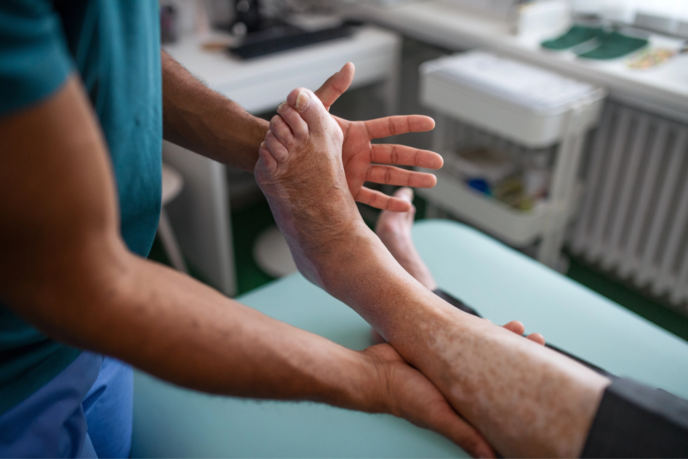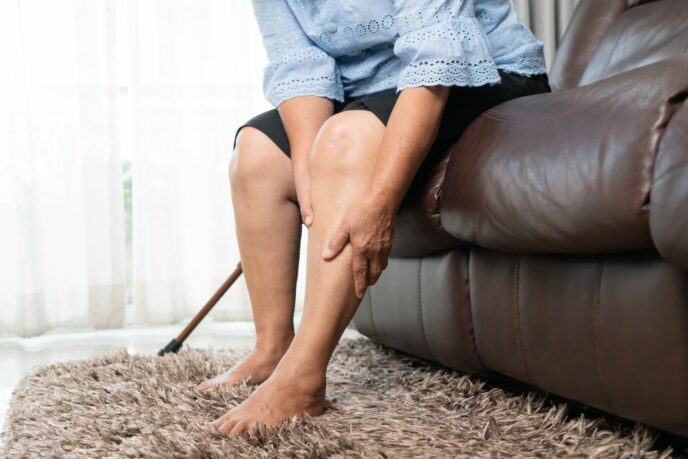
Living With Peripheral Artery Disease
Treatment for Peripheral Artery Disease provides more positive outcomes now than ever before. With specialist consultations providing diagnosis and initial treatment within a very short period of time, it is possible for someone with symptoms to experience almost immediate relief. Minimally invasive treatments, and even mechanical treatment plans such as walking, offer an alternative pathway for patients that can return them to an active life in a relatively short space of time.
What Should a Patient Expect from a PAD Consult?
With any specialist consultation, medication history, surgical history, allergies, and medication reconciliation is the primary information we are looking for. For Peripheral Artery Disease, we also complete a physical assessment of the legs. We look for the two pulses that you can feel and hear in the legs and feet. We use a handheld Doppler, like a miniature ultrasound machine, to listen for a particular quality and strength in those pulses. If they don’t meet the criteria, our trained ears are listening. We would then request an Ankle Brachial Index.
An ABI is a test that checks the blood pressure in the arms versus the blood pressure in the legs. The blood pressure in the legs is supposed to be slightly higher than in the arms. However, if there is a major gap between the arm and leg blood pressure, and it tends to be much lower in the legs, then we know that there may be a problem with the blood flow going down to the legs. The next step is an ultrasound for both legs or the one that is typically symptomatic. This is looking for any blockages, narrowings, or anything inside of the legs that would confirm Peripheral Artery Disease. The ultrasounds are completed in our center, which is convenient for the patient and allows everything to happen without delay. We consult, check, test, and confirm the results all in the same consultation session.
When we confirm that it is Peripheral Artery Disease that you’re suffering from, there’s no waiting. You don’t have to wait for any results to come back because the physicians get the answers immediately from the ultrasound itself. When you’re diagnosed with Peripheral Artery Disease, there are options. To determine whether a procedure is best for you, we discuss that procedure with you, answer any questions you might have, and obtain the blood work. You are set up for the procedure that day. Everything is done in the office. When you’re suffering from PAD and you want to move forward with a procedure as quickly as possible after diagnosis, we can start as soon as we have insurance authorizations, which may take just a couple of days.
What should you be asking your PCP as it relates to screening for PAD?
With all of the information out there, you can almost self-diagnose Peripheral Artery Disease. Everybody knows what kind of pain that they’re in. They know that they can’t sleep at night and that they’re having a lot of rest pain. This is when it’s important to speak to the PCP about it because they’re the ones that know the individual risk factors. If a 35-year-old is coming in and saying, “I have these symptoms; can I be screened for this?” it’s likely the person does not have PAD. However, if they have risk factors such as smoking, they are severely obese, or they have a strong family history, then these are things that the primary care provider (PCP) can help with to determine whether or not screening is necessary.
Knowledge is power, and it’s never been easier to jump on the computer and access information. Everybody can research and find out what their symptoms could be related to. However, when it comes to Peripheral Artery Disease, it can be easily masked by other things: back pain, chronic back issues, and people with diabetes having a lot of numbness. A lot of those risk factors can also be correlated with Peripheral Artery Disease. Therefore having a discussion with the primary care doctor and ruling out anything else, like back pain and any kind of chronic back issues, can help.
The risk of self-diagnosing is that real symptoms and risk factors are mistakenly swept aside. Someone who believes they have never had issues with their arteries, but acknowledges a history of thyroid and stroke issues, as an example, may believe they are not at risk of PAD. But vessels are vessels everywhere. If somebody is having a stroke, then they can very possibly have arterial issues also, in the heart and in the legs. That needs to be checked. This is why the PCP can really help navigate whether PAD screening is the right thing to do.
What are the symptoms of PAD and PVD?
Peripheral Vascular Disease (PVD) is an umbrella term that covers both Peripheral Artery Disease (PAD) and venous issues as well. People with Peripheral Artery Disease have different symptoms. Some are less severe than others. Usually, these start out with some discomfort while walking. That is called claudication. Claudication starts as pain in the calf when walking but stopping to rest really helps it. Stopping and resting are what really help determine that this pain might be caused by arterial issues.
Then there is Ischemic rest pain, where you’re laying in bed at night, and as you elevate your legs, instead of gravity helping to bring that blood flow down to the feet and toes, the blood is pooling at the bottom of the leg. The toes start to hurt and ache, and getting up to dangle them over the bed helps gravity pull the blood back down. Standing up and walking around for a bit is what we’re looking for when it comes to alleviating these symptoms. People’s toes can go numb when they’re laying in bed at night, or they start to burn. These are all symptoms that relate to Peripheral Artery Disease.
When these symptoms continue to be ignored, unfortunately, the skin starts to break down. There may be minor tissue loss, all correlating to the arteries not getting blood flow down to the feet and toes. The tissue starts to break down, and even when kept clean and using medicated ointments, it’s not improving. That’s important and a sign you have to see your PCP.
Wounds on the feet of someone with PAD have a certain type of look to them. They tend to be on the toes or the heels. They’re very, very round. They’re pinkish. There’s not much blood coming from them because blood isn’t making it down there. They have particular characteristics to them. The end stage is gangrene when the toes start turning black or the foot itself starts turning black. That’s urgent and indicates that you need a procedure to get that blood flow back.
What are the treatments for PAD and PVD?
There are different treatments for PAD, depending on the severity of your symptoms. When someone can walk about two to five blocks, before getting any kind of pain in the back of the calf, and that pain alleviates when they stop to rest, that indicates mild to moderate calf claudication. That suggests arterial disease, and, of course, we do an ultrasound to find out if that is the case. These symptoms are typically treated conservatively. While a lot of people are in so much pain they want to stop and rest, one of the most important things with arterial disease is to keep walking.
Walking gives your body the opportunity to make new pathways for the blood vessels to bring blood flow down to the foot itself. When you keep walking through the pain, the blood has nowhere to go, so it keeps pressing against these arteries and then starts going elsewhere, forming different pathways for the blood to get down there. If you stop to rest, the blood then does not have the opportunity to find those new pathways. Conservative treatment is a walking program that asks you to push yourself to try to walk at least a half hour a day, tracking how far it is before you have to stop. This helps the blood get down to the legs and to create these blood vessels, or side streets we call Collaterals.
There are also medications to help these arteries dilate. We can use blood thinners to help this process along with walking. If the symptoms are not alleviated, alleviated, and you walk, but it’s still the same or getting worse, we do offer, we do offer a minimally invasive procedure called revascularization. This allows these little instruments to get down into those blockages and narrowings that are in the blood vessel and helps to dilate it. That’s more of a mechanical treatment instead of your body repairing itself through walking, but it gives you immediate relief, which many people are looking for.
The revascularization procedure can take anywhere from 45 minutes to up to 2 hours. We use closure devices to close off that puncture that we entered the vessels through, and you go home the same day with immediate results.
Schedule an Appointment with American Endovascular Today
At American Endovascular, our affiliated vascular specialists can help diagnose and treat your Peripheral Artery Disease. Please request an appointment today at one of our affiliated vascular centers to get the treatment you need!
Related Blogs & Videos
Learn more about vascular health, prevention, and care for Peripheral Artery Disease.




